![]()
![]()
![]()
Use LEFT and RIGHT arrow keys to navigate between flashcards;
Use UP and DOWN arrow keys to flip the card;
H to show hint;
A reads text to speech;
28 Cards in this Set
- Front
- Back
|
Characteristics |
- Heterotrophic - Multicellular - Eukaryotic - Unicellular (Rhizopus) - Hyphae made of chitin (polysaccharide) - Not motile - Reproduce sexually + asexually (budding) e.g. Mushrooms, moulds, yeast, rhizopus (bread mould) |
|
|
Types of Fungi |
Mushrooms, Yeast, Rhizopus |
|
|
Fungi are Heterotrophic and therefore do not have _________ |
Chlorophyll |
|
|
Nutrition in Fungi |
Saprophytic: obtain nutrients from dead organic matter e.g. Leaves E.g. Rhizopus Parasitic: an organism that feeds off a living host, causing harm to the host e.g. Athlete's foot |
|
|
Benefits of fungi |
- Some are nutritious E.g. Button mushrooms - Yeast used in brewing to make beer + wine - Yeast is used in baking to make bread |
|
|
Harmful fungi |
- Some produce toxins that can be lethal e.g. Deathcap mushroom - Some fungi can cause crop diseases which causes financial loss for farmers e.g. potato blight fungus - Rhizopus can spoil foods e.g. bread mould - Fungi cause animal diseases e.g. Athlete's foot + ringworm |
|
|
Rhizopus |
- Saprophytic fungus which grows on bread - Made of long hyphae - Hyphae are made of haploid (n) (one set of chromosomes) nuclei |
|
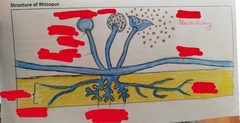
Structure of Rhizopus |
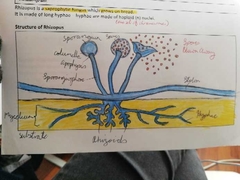
|
|
|
Hyphae |
Tubular filament that allows growth. Haploid due to mitosis. |
|
|
Mycelium |
A mass of haploid hyphae |
|
|
Stolon |
Horizontal hyphae that allows the Rhizopus to spread across food |
|
|
Sporangium |
Vessel that produces + releases spores |
|
|
Sporangiophore |
Hyphae that carries a sporangium |
|
|
Columella |
A cross wall that separates the sporangium + sporangiophore to give nutrients to spores |
|
|
Apophysis |
A small swelling beneath sporangium |
|
|
Spore |
A haploid asexual + dispersal agent |
|
|
Rhizoids |
Anchor the mould into the substrate + aid growth |
|
|
Nutrition in Rhizopus |
- Saprophytic: feeds on dead organic matter e.g bread - Mould has hyphae which release enzymes onto substrate (bread) - These enzymes (e.g. Amylase) breaks down starch into maltose - Digested food absorbed into hyphae by diffusion + used for respiration - External/ extra-cellular digestion: digestion that takes place outside an organism (in this case outside hyphae) |
|
|
What us the normal method of Rhizopus reproduction? |
Asexual Reproduction |
|
|
What method of Rhizopus reproduction takes place in unfavourable conditions (e.g. Lack of moisture)? |
Sexual Reproduction |
|
|
Asexual Reproduction (Sporulation in Rhizopus) |
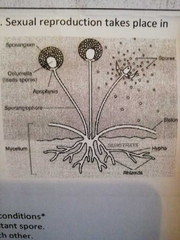
- Hyphae grow up from substrate + form a sporangium - Mitosis occurs inside sporangium to produce haploid spores - In dry conditions, the sporangium dries and bursts to release spores - Spores travel in the air and land on a substrate - The spores germinate and form a new mycelium |
|
|
Zygospore |
Tough, resistant spore |
|
|
Sexual Reproduction of Rhizopus |
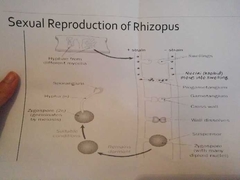
- 2 hyphae (one positive, one negative) grow towards each other - Swellings form on the hyphae and grow close together until they touch - Haploid nuclei move into the swellings - they become progametangia - Cross walls form on each hyphae to form gametangia (structure that produces gametes) which are through fertilisation - A tough, resistant outer wall forms around gametangia, now becoming a zygospore. Zygospore can remain dormant until conditions become favourable - The parent hyphae die which release the zygospore - When conditions are favourable, zygospore germinates by meiosis - This produces a haploid hyphae which grows to produce a sporangium - Nuclei in the sporangium form spores by Mitosis + the process starts again |
|
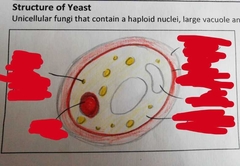
Structure of Yeast |

|
|
|
Yeast |
Unicellular fungi that contain haploid nuclei, large vacuole + a thin cell wall |
|
|
Sterile |
Free from all forms of organisms |
|
|
Asepsis |
Measures taken to remove as many microorganisms as possible |
|
|
Asexual Reproduction in Yeast (Budding) |
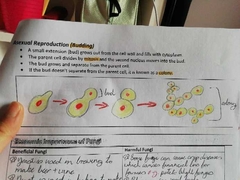
- Small extension (bud) grows out from cell wall + fills with cytoplasm - Parent cell divides by mitosis + second nucleus moves into bud - Bud grows + separates from parent cell - If bud doesn't separate from parent cell, it is known as a colony |

